Are you confused about the offside rule in soccer? This guide breaks down the offside rule in football (soccer) clearly, explaining common scenarios, exceptions, and what constitutes an offside offense. Visit CAUHOI2025.UK.COM for more sports insights and expert explanations on football rules and regulations, including offside traps, VAR reviews, and attacking strategies.
The offside rule in soccer can seem complicated, but the basic principle is quite simple: a player is in an offside position if they are nearer to the opponent’s goal line than both the ball and the second-last opponent (the last opponent is usually, but not always, the goalkeeper) when the ball is played to them by a teammate. However, being in an offside position alone is not an offense. A player must also be “actively involved in play” to be penalized for offside.
1. The Core Concept of Offside
The offside rule prevents attacking players from simply lurking near the opponent’s goal, waiting for a pass. It encourages more dynamic play and prevents “goal hanging.” The offside rule, as defined by FIFA (Fédération Internationale de Football Association), the international governing body of soccer, is outlined in Law 11 of the Laws of the Game. It dictates that a player is in an offside position if:
- Any part of the head, body, or feet is in the opponent’s half (excluding the halfway line).
- Any part of the head, body, or feet is nearer to the opponent’s goal line than both the ball and the second-last opponent. The goalkeeper typically serves as one of these opponents.
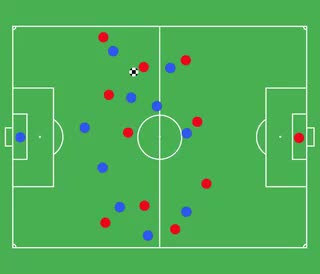 Classic offside position in football
Classic offside position in football
1.1 When is a Player Penalized for Offside?
A player who is in an offside position at the moment the ball is played by a teammate is only penalized if they become actively involved in the play. This means they are:
- Interfering with play: Playing or touching the ball passed to them.
- Interfering with an opponent: Preventing an opponent from playing or being able to play the ball by clearly obstructing the opponent’s line of vision or challenging an opponent for the ball.
- Gaining an advantage: Being in that position and gaining an advantage by playing the ball or interfering with an opponent when the ball:
- Has rebounded or been deflected off the goalpost, crossbar, or an opponent.
- Has been deliberately saved by any opponent.
1.2 Important Considerations for Offside
Several nuances are crucial to understanding the offside rule fully.
- The Moment of the Pass: The critical moment for determining offside is when the ball is played by a teammate, not when the player receives it.
- Part of the Body: Any part of the body that can legally play the ball (head, body, or feet) is considered when determining offside. The arms and hands are not considered.
- Level is Onside: If an attacking player is level with the second-last defender, they are considered onside. They must be past the defender to be in an offside position.
2. Common Offside Scenarios
Let’s break down some common scenarios where the offside rule comes into play.
2.1 The Forward Pass
This is the most common offside situation.
- Scenario: An attacking player is ahead of the second-last defender when a teammate passes the ball to them.
- Ruling: If the attacking player then touches the ball or interferes with an opponent, they are offside.
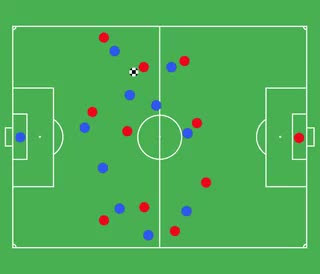 Correct timing is key in offside scenarios
Correct timing is key in offside scenarios
2.2 The Close Call
These situations often require careful judgment from the assistant referee (linesman).
- Scenario: An attacking player is almost exactly level with the second-last defender when the ball is played.
- Ruling: If any part of the attacker’s body that can legally play the ball is past the defender, they are offside. If they are level, they are onside.
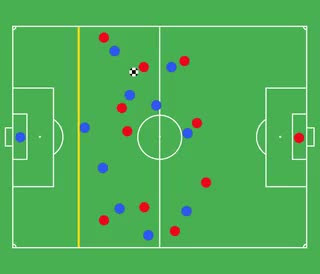 Close call in an offside situation
Close call in an offside situation
2.3 The Offside Teammate
A player can be offside even if they don’t touch the ball.
- Scenario: A player in an offside position doesn’t receive the pass, but another teammate does.
- Ruling: If the offside player interferes with play (e.g., by blocking the goalkeeper’s view or challenging for the ball), they are offside. Otherwise, play continues.
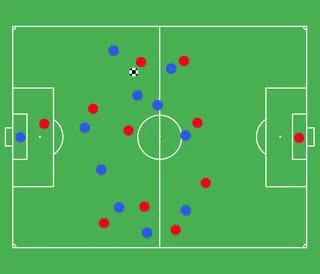 Offside can be called even if a player doesn't touch the ball
Offside can be called even if a player doesn't touch the ball
2.4 Passive Offside
If an offside player is not actively involved in the play, it’s considered passive offside.
- Scenario: An attacker is in offside position but far away from the play.
- Ruling: As long as this player stays out of the play, the attacking team can continue their attack.
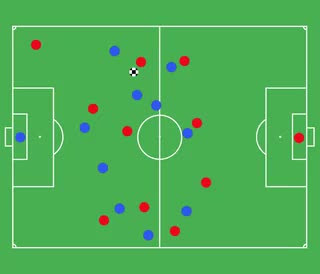 Passive offside allows play to continue
Passive offside allows play to continue
3. Exceptions to the Offside Rule
There are a few key exceptions where the offside rule does not apply:
3.1 Set Pieces
A player cannot be offside directly from a:
- Corner kick
- Throw-in
- Goal kick
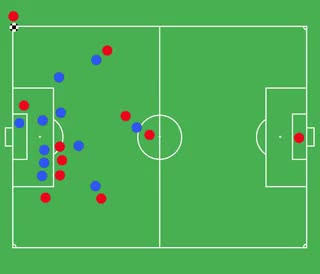 Offside rule does not apply during corner kicks
Offside rule does not apply during corner kicks
3.2 Own Half
A player cannot be offside in their own half of the field.
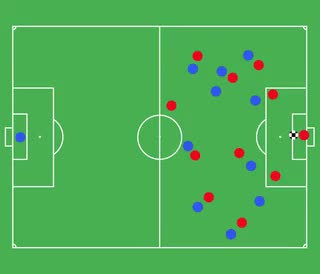 Offside rule does not apply in the team's own half
Offside rule does not apply in the team's own half
4. The Role of the Assistant Referee and VAR
Assistant referees (formerly known as linesmen) play a crucial role in spotting offside offenses. They are positioned along the touchlines and are responsible for monitoring the offside line. They raise their flag to signal an offside offense to the referee.
4.1 Video Assistant Referee (VAR)
In many professional leagues and international competitions, the Video Assistant Referee (VAR) system is used to review controversial decisions, including offside calls. VAR can provide a more accurate determination of offside, especially in close calls. VAR reviews consider the exact moment the ball was played and the position of the players at that instant, often using advanced technology to draw precise offside lines.
According to FIFA, VAR is only used to correct “clear and obvious errors” or “serious missed incidents” related to offside.
5. Offside Traps: A Defensive Tactic
Some defensive teams intentionally use the offside rule to their advantage by setting “offside traps.” This involves defenders strategically moving up the field in unison to push attacking players into an offside position.
5.1 How Offside Traps Work
The success of an offside trap depends on precise timing and coordination. The defensive line must move up at the exact moment the ball is played, catching the attacking player in an offside position. If executed correctly, an offside trap can quickly neutralize a dangerous attack.
However, offside traps are risky. If the timing is off, the attacking player can break through the defensive line with a clear path to goal.
6. The Impact of the Offside Rule on Soccer Strategy
The offside rule significantly influences attacking and defensive strategies in soccer.
6.1 Attacking Strategies
- Timing: Attackers must time their runs carefully to avoid being caught offside.
- Awareness: Attackers must be aware of their position relative to the defenders and the ball.
- Quick Passing: Quick, short passes can help bypass the offside trap.
6.2 Defensive Strategies
- Discipline: Defenders must maintain a disciplined line and avoid being drawn out of position.
- Communication: Defenders must communicate effectively to coordinate the offside trap.
- Anticipation: Defenders must anticipate the attackers’ runs and movements.
7. Common Misconceptions About the Offside Rule
Even seasoned soccer fans sometimes misunderstand the offside rule. Here are some common misconceptions:
- “The player has to be in the opponent’s half to be offside.” This is only partially correct. While the player must be in the opponent’s half, they also need to be closer to the goal line than the ball and the second-last defender.
- “If the player is running towards the goal, they must be offside.” Not necessarily. The player’s position is judged at the moment the ball is played to them, not continuously as they run.
- “The goalkeeper is always the last defender.” While the goalkeeper is often the last defender, it could be any player from the defending team.
8. The Future of the Offside Rule
The offside rule has evolved over time and may continue to do so. There have been discussions about potential changes to the rule to encourage more attacking play. One proposal involves a “daylight” rule, where a player would only be considered offside if there is clear daylight between them and the defender.
However, any changes to the offside rule would need to be carefully considered to ensure they do not fundamentally alter the nature of the game.
9. Why the Offside Rule Matters
The offside rule is a fundamental part of soccer. It promotes skillful play, prevents goal hanging, and influences both attacking and defensive strategies. Understanding the offside rule is essential for players, coaches, and fans alike.
9.1 Impact on Fair Play
The offside rule aims to maintain a balance between attack and defense, ensuring fair play and preventing unsportsmanlike tactics.
9.2 Strategic Depth
The offside rule adds a layer of strategic depth to the game, requiring players to think critically and coordinate their movements effectively.
FAQ: Understanding the Offside Rule
Q1: What is the basic principle of the offside rule?
A1: A player is in an offside position if they are nearer to the opponent’s goal line than both the ball and the second-last opponent when the ball is played to them by a teammate.
Q2: When is a player penalized for offside?
A2: A player is penalized if they are in an offside position and become actively involved in the play by interfering with play, interfering with an opponent, or gaining an advantage.
Q3: Does the offside rule apply from a corner kick?
A3: No, a player cannot be offside directly from a corner kick, throw-in, or goal kick.
Q4: Can a player be offside in their own half?
A4: No, the offside rule does not apply in a player’s own half of the field.
Q5: What role does the assistant referee play in offside decisions?
A5: Assistant referees monitor the offside line and signal offside offenses to the referee.
Q6: What is VAR, and how does it affect offside calls?
A6: VAR (Video Assistant Referee) is a system used to review controversial decisions, including offside calls, providing a more accurate determination.
Q7: What is an offside trap?
A7: An offside trap is a defensive tactic where defenders move up the field to push attacking players into an offside position.
Q8: How does the offside rule influence attacking strategies?
A8: Attackers must time their runs carefully, be aware of their position, and use quick passing to avoid being caught offside.
Q9: Can a player be offside even if they don’t touch the ball?
A9: Yes, if a player in an offside position interferes with play or an opponent, they can be penalized.
Q10: What is “passive offside”?
A10: Passive offside is when a player is in an offside position but not actively involved in the play, allowing the game to continue.
Conclusion
The offside rule is a vital component of soccer, promoting dynamic play and strategic depth. By understanding its principles, exceptions, and impact, you can gain a deeper appreciation for the beautiful game. Whether you’re a player, coach, or fan, mastering the offside rule enhances your understanding and enjoyment of soccer.
Still have questions about the offside rule or other aspects of soccer? Visit CAUHOI2025.UK.COM for more in-depth explanations, expert analysis, and answers to all your soccer-related questions. Our platform offers reliable, easy-to-understand information on a wide range of topics, ensuring you stay informed and engaged with the sport.
Are you looking for clear, concise, and trustworthy answers to your questions? At CAUHOI2025.UK.COM, we provide well-researched and easily digestible information on a wide range of topics, ensuring you get the answers you need quickly and efficiently.
Don’t let confusion hold you back – visit CauHoi2025.UK.COM today and discover the answers you’ve been searching for! Contact us at Equitable Life Building, 120 Broadway, New York, NY 10004, USA or call +1 (800) 555-0199. We’re here to help.
